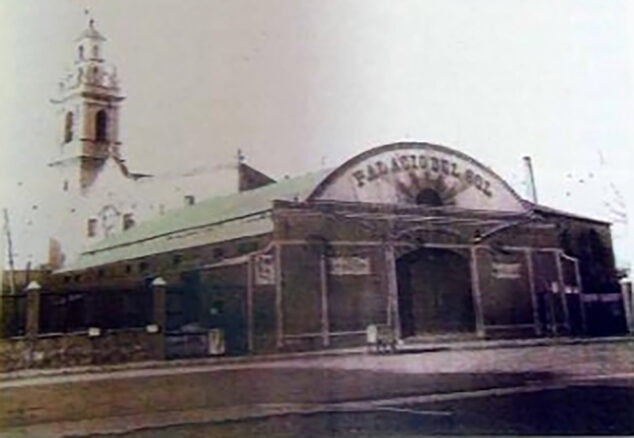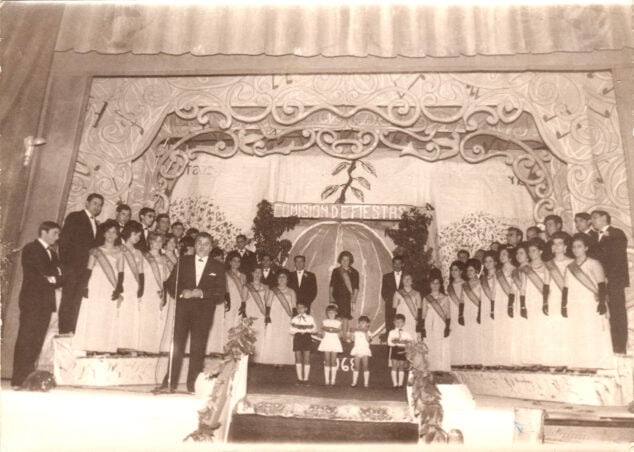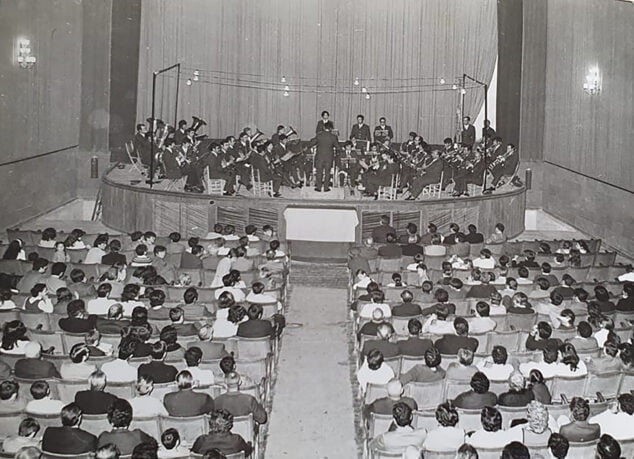The Marina Alta has been a prolific land in cinemas and theaters for film reproduction. Implicit in the history of its towns is the location of many of these places that now remain in the memory of the older residents and of many others who find among the memories of their ancestors snapshots that corroborate the remembrances.
At the beginning of the XNUMXth century, in the region there were some 23 movie theaters registered, which were distributed by its geography, either on the coast or in the interior. Although the presence of the cinematograph in the Marina Alta was more notable from the 50s, in the first half of the century theaters that reproduced the first silent films began to appear.
Many of them were not used only for movie passes. They were wide spaces, with capacity for many people, where you could sit and enjoy cultural and leisure shows that were carried out between its large stages or festive events in the town.
This is, therefore, a short journey through the most recognized or remembered rooms in the region, open to nuances and corrections. Based on information in the book Dénia, a city of cinema, by Antoni Reig Pérez and Miquel Crespo Ronda, and in personal sources that best describe the history of cinematography in the Marina Alta.
Next you have an index with all the points that we are going to deal with.
- 1.
- 2.
- 3.
- 4.
- 5.
- 6.
- 7.
- 8.
- 9.
- 10.
- 11.
- 12.
- 12.1.
- 12.2.
- 12.3.
- 12.4.
- 12.5.
- 12.6.
- 12.7.
- 12.8.
- 12.9.
Xàbia
Xàbia It was the most advanced town in the region to house cinemas. The arrival of the big screen in the town was in 1915, when Antonio Llopis Espinós inaugurated the Cinema Espinos. This was closed in 1972 and due to the state of abandonment of the building it was demolished in the 90s.
But the streets of Xabiera not only saw a single room. The town was the one that housed the most cinemas in the entire region. Between covered and outdoor spaces, Xàbia It retains in its history the existence of no more and no less than nine cinemas. After the first mentioned, came the Verano Espinós cinema (1940s), Monterrey Cinema (1954) Central Cinema (1955) The Jayan Terrace (1958) the Jayan Cinema (1973), the Xàbia drive-in (1982) Arenal Terrace Cinema (1983) and Costablanca Terrace Cinema (80s).
Dénia
The capital of the region, for its part, had up to five cinemas. Some of them coexisted with each other, since until the appearance of television in homes, the cinema was the main source of leisure and socio-cultural entertainment in the XNUMXth century.
As previously mentioned, many of the rooms were dedicated to another type of show, such as theatre. This explains why some of them were earlier. Thus, in Dianense's memory remain the Circus Theater (1895), the Palace of the Sun (1912), the modern living room (1923) The Rose Garden (1951) Cinema Sun (1951), the Avenue (1963-1972) and the County (1966). The latter remained open until 2008 and currently continues as a nightclub and nightclub.
Another mention deserves Drive-In Drive-In, the longest-lived in the history of the country, which was born in 1979. Located in the municipality of Dénia, it was very frequented by residents of El Verger due to its proximity to Les Deveses beach. Currently, it is still in operation, being a great attraction in the region, especially on summer nights.
Pego
The cinematograph arrived in Pego soon, being another of the first towns to have one. Physically, the Pegolina town has had two cinemas, which later changed their names. The first projector arrives with the Pathé Cinema, approximately in 1925, according to information provided by the Pego Municipal Archive. Its name referred to one of the great pioneering companies in film production and distribution. After the Civil War, this would be renewed as the Victoria Cinema.
In 1933, the Casa del Poble is the location where the Llibertat Cinema, which would later be called Cinema Spain. But, in addition to the closed rooms, Pego had two terraces where movies were shown outdoors.
The Municipal Archive documents the existence of the Terrassa Victoria, which was built in 1953 «in the current Mar street, in the quintana of Eduardo Mengual». It was a dance and cinema floor built by the Ortolà family, better known by the Pegolinos as the “Llana”. For their part, the Falgàs family, owners of Cinema España, built next to the main room the Track Spain in 1943. This also had a dance area and an open-air cinema.
Ondara
Another great nucleus of the cinematographic culture of the XNUMXth century was Ondara. He Zamenhoff Cinema It was the place from the beginning of the century where silent film productions were shown. This disappeared with the entry of the sound. He too Slavic Theater, with an offer of dances, concerts, movies, theaters and others, was one of the great references in the Marina Alta until its demolition in the 60s.
After the Civil War, the Victoria Cinema, which could not resist the decline of the 1980 film exhibition. Fortunately, it was bought by the Ondarenc City Council, giving space to the current Auditori d'Ondara. By your side, My garden, very appreciated among the neighbors and neighbors and a large part of the region, was the terrace and the summer cinema of the town.
La Joya Levantina, that is, Plaça de Bous d'Ondara, also offered summer film screenings between 1950 and 1960, while the offer alternated with bullfighting.
The Verger
The López Cabrera family is well known in the history of Verger for its contribution to local music. The patriarch "ti Vicent" (Vicent López Carrió), founder of the local Musical Society, launched the casino and also the cinema. Thus, the Lopez Cabrera Cinema It already offered shows in 1930. The room was a great source of culture in the town and the region, as well as being used as a space for events for Verger's patron saint festivities.
The building was long, inside it contained a large seating area, at that time wooden benches made by the son of you Vicent, Antonio López Cabrera, as well as a "fumadero", bathrooms, space for a bar counter and a room where costume changes can be made in theater and singing performances. The cinematographic reproduction lasted until the 80s and then continued to be used for other cultural events until its demolition.
In the postwar period, summer cinema Monumental Cinema began to compete with the López Cabrera. Property of Francisco Doménech, the "Calpero", it was the opportunity to combine the cinematographic offer in El Verger. While this one worked during the hottest months of the year, the other covered cinema rested from its activity.
Pedreguer
In Pedreguer the serrano theater with the arrival of the cinematograph to the world, being one of the pioneers in the exhibition of films. When the talkies broke into the seventh art industry, it opened the modern cinema and world cinema. The second with a summer terrace included.
Around 1960, Antonio Costa Pedro, "Palero", bought both spaces, although after the acquisition the Mundial Cinema closed and the Modern Cinema managed to extend its life until the 90s.
Calp
In 1917, the society made up of Bernardo Sala, Jaime Crespo and Mateo Zaragosa allowed the introduction of the cinematographic exhibition in the town of El Peñón with the Alhambra Cinema. With capacity for 250 people, although later it would become 360 locations, it allowed them to set up another open-air space nearby, the Alhambra terraceIn 1964.
In 1965, the cinema moved from Calle Puríssima to Comte d'Altea, doubling the capacity of the previous room. Also that year was born Victoria Cinema by the hand of Joaquín García Hernández as summer cinema. Three years later, it was expanded as a venue for parties and shows.
Gata de Gorgos
Until relatively recently the Cinema La Paz it was still working, mostly playing children's movies. The fame of the long-lived Maties Monfort movie theater, the “ti Passetes”, was already palpable in the 30s under the name of Salón La Paz. The film offer in Gata de Gorgos during the same decade multiplied with the ideal cinema, later called Casablanca from the 60s. The town also had the opportunity to enjoy a summer terrace, the Avenue.
Benissa
The streets of Benissa hosted two cinemas before the arrival of the war, one of them would change its name later. He ideal cinema, with long benches, belonged to "uncle Roig" and was located on Pare Melcior street. It could not overcome the convulsive years of the war and had to close its doors. He dore room, for his part, resisted, although later he was better known as the goya hall.
Teulada
Juan Cervera in Teulada managed to stably maintain his Cervera Cinema until the 70s. The businessman had little competition in the world of showing films in the town.
El Poble Nou de Benitatxell
Teulada businessman Juan Cervera broadened his horizons in El Poble Nou de Benitatxell and brought the residents the possibility of having a cinema with the Theater-Cinema Cervera.
More movie theaters
The lack of information on movie theaters in smaller towns makes the collection imprecise. However, a list is offered with the data collected from the aforementioned work by Antoni Reig and Miquel Crespo. Many of these rooms appeared between the 40s and 50s, although other municipalities already had them since 1930.
Orba
- Isber Cinema.
- Music Cinema.
Alcalali
- Projections in the Hall-theater of the Agricultural Union.
Mineli
- Fabian Cinema.
Fleix, Vall de Laguar
- La Lira Cinema.
Benigembla
- Modern Cinema.
Xaló
- Jalón Cinema.
Festival
- Capitol Cinema, later Baherma Cinema.
Ràfol d'Almúnia
- Cinema News Pastor.
Parcent
- Cinema Spain
Bibliography
- Reig Pérez, Antoni and Crespo Ronda, Miquel (2004). Dénia, ciutat film. Dénia Town Hall and Juan Gil-Albert Alacantí Institute of Culture.
*You can provide more information about the theaters and cinemas in the Marina Alta, commenting on this article or sending information to info@lamarinaalta.com indicating the town.





















And now how many theaters are left?
How many does Dénia have??? 000000